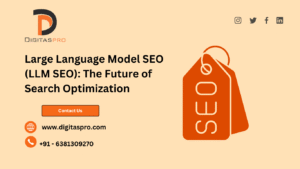Introduction
In a world where artificial intelligence is rapidly changing how we interact with information, the emergence of Large Language Models (LLMs) like ChatGPT, Claude, Gemini, and others has fundamentally shifted the digital marketing landscape. Traditional SEO, while still valuable, no longer guarantees top visibility in this new era. Instead, a new discipline has emerged: LLM SEO.
LLM SEO—sometimes referred to as AI SEO, AEO (Answer Engine Optimization), or GEO (Generative Engine Optimization)—is about optimizing your content not just for search engines like Google or Bing, but for the AI-driven platforms that now influence millions of daily information requests.
This comprehensive guide explores LLM SEO, key strategies for implementation, real-world applications, and how we at DigitasPro Technologies are helping brands adapt and thrive.
What Is LLM SEO?
LLM SEO refers to the practice of optimizing digital content to be discoverable, relevant, and referenced within the outputs of large language models (LLMs). Instead of merely trying to rank #1 on Google, the goal of LLM SEO is to make your content usable, cite-worthy, and retrievable by AI systems.
This includes:
- Structuring content for machine-readability
- Including direct, concise answers for FAQs
- Using schema markup and metadata
- Leveraging tools like llms.txt to control LLM indexing
With the rise of AI-powered search features like Google’s AI Overviews, OpenAI’s ChatGPT browsing, and Perplexity.ai, LLM SEO is becoming as important as traditional on-page and off-page SEO.
Key Principles of LLM SEO
- Focus on E-E-A-T (Experience, Expertise, Authoritativeness, Trustworthiness)
- Demonstrate credibility with expert bylines, research citations, and transparent authorship.
- Write for Conversational Queries
- LLMs respond best to natural language, question-based, and instructional content.
- Answer Engine Optimization (AEO)
- Structure content to directly answer common questions within 2–3 sentences.
- Implement Structured Data and Schema Markup
- Use FAQPage, HowTo, and Article schemas to make content machine-readable.
- Use llms.txt
- Like robots.txt but for LLMs, this file guides how your content is crawled and cited.
- Create Content Clusters
- Interlink related pages to build topical authority.
- Maintain Content Freshness
- Update articles regularly to reflect new data, trends, and examples.
- Optimize for Speed, Mobile, and Accessibility
- AI and human users both favor clean, fast-loading, mobile-friendly experiences.
How DigitasPro Technologies Implements LLM SEO
Step 1: Audience and Query Research
We identify high-intent, question-based queries your users (and LLMs) are most likely to engage with.
Step 2: Semantic Keyword Mapping
We create topic clusters built around core themes and use LLM-powered keyword tools to find relevant subtopics.
Step 3: Drafting with AI + Human Expertise
Using AI as a drafting assistant, we develop content and enrich it with insights from your internal experts.
Step 4: Structured Formatting
We format content with headings, bullet points, tables, and lists to aid LLM parsing.
Step 5: Schema and Metadata Implementation
We add structured data and rich metadata to ensure machine readability.
Step 6: llms.txt Deployment
We help you create a llms.txt file that defines how LLMs should crawl or cite your content.
Step 7: Monitoring AI Mentions
We use analytics and custom tracking to monitor when and where your content appears in AI-generated answers.
Real-World Applications
Case Study: B2B SaaS Blog Optimization
A mid-tier SaaS company saw a 3x increase in branded citations in AI tools like ChatGPT and Perplexity.ai after restructuring their knowledge base with LLM SEO best practices.
Case Study: E-commerce Product Pages
By using structured data and FAQ sections, an e-commerce brand boosted its inclusion in Google’s AI Overviews by 50% within two months.
FAQs
Q1: How is LLM SEO different from traditional SEO? Traditional SEO aims for search engine ranking positions; LLM SEO ensures your content is accessible and cited by AI models.
Q2: Do I still need backlinks for LLM SEO? Yes. Backlinks still build authority, which LLMs use as a signal for trustworthiness.
Q3: What is llms.txt and how do I implement it? llms.txt is a new protocol that helps you control how LLMs crawl and use your content. It’s a simple text file hosted at the root of your domain.
Q4: Will optimizing for AI reduce my traffic? Not necessarily. It may reduce reliance on clicks, but boost brand visibility and authority.
Q5: Can small websites benefit from LLM SEO? Absolutely. Smaller sites with focused content often outperform larger ones in AI-generated answers if well-structured.
Conclusion
LLM SEO is not a replacement for traditional SEO—it’s the next evolution. As AI tools increasingly mediate search behavior, content strategies must evolve to meet machine and human needs alike.
At DigitasPro Technologies, we’re helping brands adapt to this future with a hybrid approach that combines cutting-edge AI tools with human expertise.
Want to optimize your content for the AI era? Get in touch with our LLM SEO specialists today.
About DigitasPro Technologies
We’re a Chennai-based digital agency helping global businesses thrive with innovative SEO, content, and AI solutions. Learn more at Digitaspro.com.

